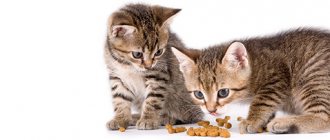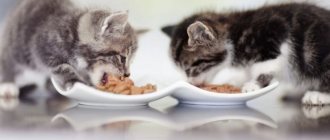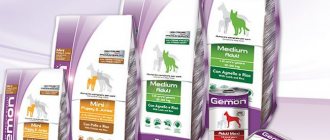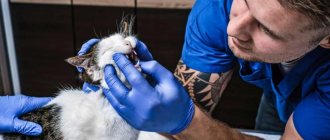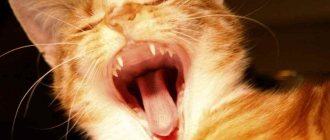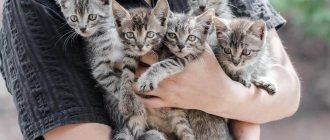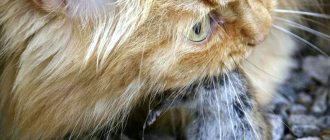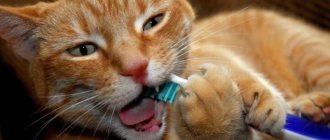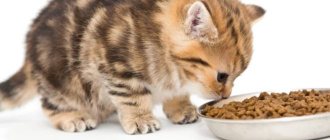In the article, we looked at the questions that owners have when introducing complementary foods to kittens. What is the best time to start complementary feeding, how and what to feed newborn kittens and kittens from one to three months. From the material you will learn which foods are prohibited for kittens to eat and why water is important for the health of the animal.
For the first three to four weeks of life, kittens feed on the milk of their mother cat. But over time, it becomes insufficient to develop properly, grow healthy and strong. At about the age of one month, kittens need to be introduced to complementary foods, which means they should begin to accustom them to adult food.
In order for kittens to grow up healthy and strong, you need to introduce complementary foods
Optimal time to start complementary feeding
Owners often have questions about when to start feeding kittens and what is best to feed them – natural food or ready-made industrial food.
Complementary foods can be introduced into the diet of kittens 20-21 days after birth. This procedure must be carried out up to six times a day, every 3-4 hours. Complementary feeding for kittens is usually started simultaneously with the consumption of mother's milk. Food is an addition; it must be soft, warm, and the portions are small, because babies have not yet learned to chew.
If you plan to feed your cat dry food in the future, you can make a paste out of it and give it to the kittens. The store sells special food for tailed babies of different breeds. Several pads are soaked in water and carefully spread on the kitten’s palate. Then a bowl of food soaked in water is placed in front of him. Gradually he must understand what is required of him. The amount of water added to the food should be gradually reduced, and by two months the baby will be able to chew the pads on his own.
Add cottage cheese
Another useful product for feeding a kitten. They do it themselves. Take yogurt or kefir. The fattier these products are, the better the quality of the cottage cheese.
Pour into a saucepan, heat over low heat. We don't touch it for the first 5 minutes. Then take a spoon or slotted spoon and stir the product. It should not stick to the bottom of the pan.
When the curd begins to separate, sinking to the bottom, it is almost ready. It should be floating in a greenish whey. If the whey is this color, turn off the heat.
Next, take gauze folded in several layers. Place the cottage cheese on it. Gauze is placed in a colander to drain the whey from the curd. Then we hang a knot of gauze and leave it to ripen for 12 hours.
This cottage cheese is suitable not only for feeding a kitten. You can eat it yourself.
How to feed artificially
Sometimes cats, for some reason, abandon their kittens; they may not have milk to feed; tiny kittens can be found on the street or in the entrance. This is very dangerous for the lives of small animals, so you need to provide the kittens with care, care and proper feeding.
Only a human can help a defenseless kitten
Portion calculation
Complementary feeding for kittens left without a mother can be done using dry formulas that replace cat's milk, which are sold in pharmacies, or you can prepare a liquid mixture from natural products.
Milk replacers are sold in powdered and liquid forms. The powder is diluted with water as indicated on the packaging by the manufacturer. The unused portion is stored in the refrigerator. The mixture should not be allowed to freeze.
In the first seven days, the daily norm is 30 ml of formula per 100 grams of kitten weight. Further, until the age of two weeks, the amount of food increases to 40 ml per 100 grams of weight.
To replace cat milk, you can prepare several mixtures yourself:
- Dilute 250 grams of cream with 10% fat content with warm water in a ratio of 1 to 2;
- Mix a portion of goat milk with egg white in a ratio of 4 to 1 until smooth;
- Dilute condensed milk without sugar with water in a ratio of 5 to 1, add a teaspoon of bone meal to the mixture.
Raw cow's milk is contraindicated for newborn kittens; digestive problems may occur. You can use goat's milk for complementary feeding.
You can prepare your own formula for complementary feeding
Starting from the eighth day, kittens should be given liquid vitamin preparations prescribed by a veterinarian every other day.
The best food option for kittens is to use specially formulated cat milk replacers. The use of these mixtures practically guarantees the absence of problems with intestinal microflora in the future.
Rules for introducing complementary foods
There are general rules for feeding kittens that must be followed:
- Kittens are fed only in a prone position (natural) or held upright (with a weakened sucking reflex). A kitten may choke if placed on its back.
- Strictly control the gradual flow of the mixture, as the kitten may inhale excess liquid.
- You can feed using a pipette or a medical syringe without a needle. It is best to purchase a special bottle with a pacifier for kittens.
- The bottle should be held at a comfortable angle for the kitten, but not vertically or horizontally. The angle is approximately 45 degrees.
- After feeding, you need to massage the kitten's belly with a moistened piece of cloth or a damp sponge to stimulate digestion. This step cannot be skipped, because the kitten will not be able to go to the toilet and will suffer from intoxication. Under normal conditions, this is done by the mother cat. The kitten should relieve its natural needs 2-3 times a day.
- It takes about 5 minutes for a kitten to eat. If he sucks sluggishly and begins to fall asleep, it means he is full.
- Never force-feed leftover formula, even if your baby doesn't seem to have eaten enough. It is better to take a break and offer the pacifier again after 30–40 minutes.
- It is necessary to pay attention to the temperature of the food. Cold food disrupts digestion, hot food burns the oral cavity. From the first days of feeding, the temperature should be 37 degrees - an approximate indicator for the kitten’s body. Every week you need to lower this degree. By the end of the month, the mixture should be at room temperature - 24 degrees.
- Pipettes or bottles must be sterile; to do this, they must be boiled regularly.
It is better to feed babies with a bottle
Kittens' weight needs to be monitored. Slow growth indicates that the animals are malnourished. If kittens begin to suck the finger extended to them and squeak all the time, then they are hungry. Until about three weeks of age, they should gain 10-15 grams every day.
How often to give complementary foods
Kittens' diet changes almost every day. When feeding kittens with cat milk substitute formulas, you must follow the instructions on the package. Generalized recommendations for feeding frequency and portion sizes are as follows:
Days 1-4, the amount of mixture is 30 ml per 100 grams of weight every two hours around the clock.
Days 5-13, the amount of mixture is 38 ml per 100 grams of weight every 4 hours.
14-24 days the amount of mixture is 46 ml per 100 grams of weight every 4 hours. Formula milk can be poured into a saucer to encourage kittens to lap on their own. From the 15th day, kittens can be fed additionally.
25-35 days amount of food 53 ml per 160 grams of weight. During this period, it is necessary to feed the kittens with other foods and introduce solid food.
Failure to adhere to the feeding schedule can lead to health problems.
Table: overview of the four most popular brands of kitten food
| Brand | The first 10 ingredients in the composition | Average cost 1 kg | Advantages | Flaws |
| Royal Canin |
| 600 rub. | Thanks to the use of easily digestible components, the load on the gastrointestinal tract is reduced, so the chance of developing pathologies even in the presence of risk factors is minimal. Despite the weak composition, sometimes Royal Canin food does not cause side effects in kittens with sensitive digestion. | Overpriced. The manufacturer uses too many anonymous ingredients and isolated protein instead of whole muscle tissue. |
| Orijen |
| 700–800 rub. | The food mainly consists of meat. The list of ingredients includes preventive additives. Pears, apples and other fruits and berries prevent the development of KSD. Plant components contain fiber, which is necessary for the proper functioning of the gastrointestinal tract. Fish contains unsaturated fatty acids that help strengthen the immune system. The line includes a special food that is suitable for kittens, which is not typical for holistic people. | High price. The food is not suitable for all kittens due to excess meat and fat in the composition. If the baby has previously eaten products from another brand, it is better to postpone the transfer. |
| Acana |
| 700 rub. | Contains enough meat. The composition contains preventive additives: cartilage, tripe, turmeric, etc. They improve digestion, maintain healthy joints and strengthen the immune system. The manufacturer states that all food in the line is suitable for both adult cats and kittens. | High price. Compared to Orijen foods, Acana products contain less meat. |
| Go! |
| 500 rub. | The line includes whole grain and grain-free food, as well as a dietary diet for cats and kittens with sensitive digestion. The cost is reasonable. | Whole grain food contains too many grains. |
What to include in your diet
From the very first days of complementary feeding, owners need to choose a method of feeding the kitten and constantly adhere to it. In no case should you alternate natural products and industrial feeds - in this case it is impossible to maintain the optimal balance of vitamins and minerals, and an excess of any element can be no less harmful than its deficiency.
Throughout the cat’s life, you need to adhere to the feeding method chosen in childhood.
Diet of a kitten aged 1-1.5 months
Food for a 1 month old kitten should be similar in consistency to milk. Avoid hard foods and large pieces. The pet's body simply cannot digest such food.
New foods should be introduced into the diet every two to three days. The product is introduced gradually and in small portions.
Month-old kittens cannot control their food intake, so portion sizes must be observed. In addition, feeding too often can cause a negative reaction from the digestive system.
The list of products for a one-month-old kitten will be quite limited. The pet's jaws are not yet designed to chew large pieces of food, and the gastrointestinal tract is not able to digest many foods.
Veterinarians recommend starting complementary feeding for pets with liquid milk porridges, goat milk, low-fat cottage cheese, lean boiled meat or scraped raw meat.
At the age of 1-1.5 months, the average number of feedings per day should be 5-6 servings. For 100 grams of kitten weight you need to prepare 50-55 ml of prepared food.
In order to be sure that the kitten’s body receives all the necessary substances, you can buy additional vitamins and supplements. They should be selected after consultation with a veterinarian.
One-month-old kittens can be given goat's milk in small quantities.
A kitten that does not eat natural food should be fed high-quality ready-made food.
If the kitten will continue to eat ready-made dry or wet food, then it is necessary to start complementary feeding with them. Food must be chosen that is specialized for small kittens and takes into account the breed.
You need to start feeding kittens at three to four weeks of age. However, they must still receive breast milk or a milk substitute. Kittens need to be fed up to five times a day, every three to four hours. Portions should be small, and food should be warm and softened, since babies do not yet know how to chew.
Complementary feeding at 2 months of age
From two months, kittens can already eat more solid food. They still need to be fed 5-6 times a day in small portions.
At this time, the kitten’s diet may consist of liquid porridge (oatmeal, rice) cooked in milk, scraped meat, boiled vegetables (carrots, zucchini, pumpkin) in the form of puree or finely chopped with the addition of vegetable oil, kefir, cream, yogurt (natural , no additives or sugar).
The best meat for kittens at this age is lean beef, rabbit, chicken, and turkey. No more than once a week you can give offal: chicken and beef liver, heart. They are fed finely chopped or ground with porridge.
If you plan to switch kittens to dry or wet ready-made food, then this should be done after 2 months. The food must be of high quality and special for kittens.
Dry food should be specially selected for the age and breed of the kitten.
Nutrition for a 3 month old kitten
At three months of age, kittens’ skeletons become stronger, muscles grow, and teeth change. Kittens play and run a lot, exploring their surroundings. Therefore, they need an appropriate diet rich in nutrients and vitamins.
Three months is the age when it is time to finally switch the kitten to adult food. The number of feedings is reduced to 5 times a day.
The diet of a three-month-old kitten should include: raw meat (chicken, turkey, beef, rabbit), offal (liver, heart), porridge (oatmeal, buckwheat, rice), raw and boiled vegetables (carrots, cauliflower, zucchini, pumpkin), cream , kefir. You can introduce sea fish, no more than 2 times a month.
When choosing ready-made food, you should give preference to premium food. Food must be specially selected for the age and breed of the kitten.
Three month old kittens are very energetic and require a more nutritious diet.
From three months and older
The diet is expanding again. Now the baby is given offal, but only in boiled form, of course. Fish is also allowed for a growing child. Strictly seafood, boiled, without bones.
According to some reports, cream can be given to a kitten. We strongly ask you not to do this. This is too fatty a product. The baby's stomach can't handle it. A kitten will get diarrhea if you give it cream to drink.
Kefir is a different matter. You can add half a teaspoon of sugar to it and treat the kitten. The kid will appreciate this drink.
Starting from the age of three months, remove milk from your pet’s diet. It is replaced with kefir or natural yogurt.
Prohibited foods for the diet
It is recommended to exclude the following products from the kitten’s menu:
- milk and fatty dairy products;
- fried and salted foods;
- smoked meats and sausages;
- pork;
- River fish;
- potatoes, tomatoes, grapes, citruses, pineapple, kiwi;
- chocolate and bakery products;
- bones of animals, birds or fish;
- food from a person's table;
- dog food.
To prevent your kitten from eating prohibited foods, you need to follow these simple tips:
- Do not allow the kitten to sit on the table while preparing or eating food.
- Don't feed table scraps.
- During the holidays, be on your guard - scents can tempt even the most well-mannered and obedient animal.
- Keep food out of the kitten's reach. If he shows interest, install special locks on the cabinet doors.
Don't let the kitten sit on the table
Prolonged feeding of a kitten with human food leads to metabolic disorders, diseases of the gastrointestinal tract, heart and blood vessels.
Poor quality of the finished food or intolerance to a certain type can cause digestive problems in the kitten. In this case, you should consult a veterinarian and choose a different type of food or a different type and brand of food; it is better to give preference to products with a higher price. Saving on the animal's nutrition will negatively affect its health and will lead to even greater costs for the treatment of diseases that arise as a result of eating low-quality food.
Water in the diet
The process of transitioning from cat milk or milk replacer involves gradually increasing your drinking water intake. Water is very important to keep kittens healthy and active. At about 4 weeks of age, as soon as the kittens begin to eat solid food, they need to have access to clean, fresh water.
It is advisable not to use a plastic bowl; it should be made of metal, glass or porcelain. It is better to place the bowl a little away from the place where the kittens eat. You can place several bowls of water throughout the apartment. A good solution would be to purchase a special drinking fountain.
Water is very important for a kitten's health
Features of complementary feeding of individual breeds
When introducing complementary foods and preparing a diet, you need to take into account the characteristics of cat breeds. For most species, standard rules apply. But there are breeds that have certain characteristics that require correction in the complementary feeding regime.
Ragdoll kittens have a genetic disease: hypertrophic cardiomyopathy (thickening of one of the walls of the heart ventricle) and joint dysplasia. Therefore, the list of prohibited products additionally includes: meat of geese and ducks, cream, and fatty sour cream. Their consumption negatively affects cardiac activity and disrupts metabolism.
Little ragdolls
Sphynx kittens (like other representatives of hairless breeds) have a high risk of developing cardiovascular diseases. They can only be given dietary meat: turkey or chicken, rabbit, beef. Pork should not be given to any cats, and especially not to sphinxes. To start feeding, raw or boiled veal is suitable.
A Sphynx kitten needs to be fed more often than a regular cat. Six to eight meals are recommended up to two months, four meals up to five months. At the age of six months, reduce the frequency of feedings to three times a day, and from the age of nine months, accustom them to two meals a day.
Sphynx kittens
Maine Coons mature late. Cats usually feed their babies for up to two months. These kittens do not need to be fed complementary foods until they are 8 weeks old.
Maine Coon kittens differ from all others in their large size. Accordingly, more food is needed. At the age of two months, kittens should receive 130 grams of meat, up to 40 grams of vegetables and dairy products, and about 15 grams of cereal. For other breeds, this is the norm for an adult cat.
Maine Coon kittens are larger than kittens of other breeds
When to start feeding kittens - why exactly a month?
You can start feeding at any time, but it is at one month that they begin to lack milk. That’s why it’s worth giving extra food, and the feeder should be friendly. Before feeding, you can try to play with the baby to win him over.
Important!!! correctly determine when to start feeding kittens, since it is during the process of introducing complementary foods that the basic skills of a four-legged cat are formed. You will teach him to eat food on his own, he will receive the necessary knowledge.
General recommendations
If it is decided that the kittens will eat only natural food, it is advisable to accustom the pets to eating a variety of foods from the first month. You should not give your animal one product he loves and make it the main one in his diet. This can lead to digestive problems.
A great danger to a kitten's health is feeding human food in combination with ready-made food. It is also not recommended to mix expensive dry food with cheap wet food. It is better to leave only dry food, since low-quality wet food will do nothing but harm to the kitten.
Pay attention to the kitten’s fur as often as possible: if it is shiny and smooth, then the pet is healthy. If bald spots appear or the skin under the fur is irritated, you need to consult a veterinarian and purchase a special vitamin complex. But remember that in a good ready-made food, all nutrients and microelements are already balanced.
Nutrition up to one month of age
All of the above is given to the kitten before it reaches one month of age. Then new foods are introduced into the diet.
Chicken yolk begins to be given from 21 days. They just do it extremely carefully. They start with a grain, in the literal sense of the word. If the baby reacted normally to the product, they give a little more. And they closely monitor the baby’s reaction to the innovation.
